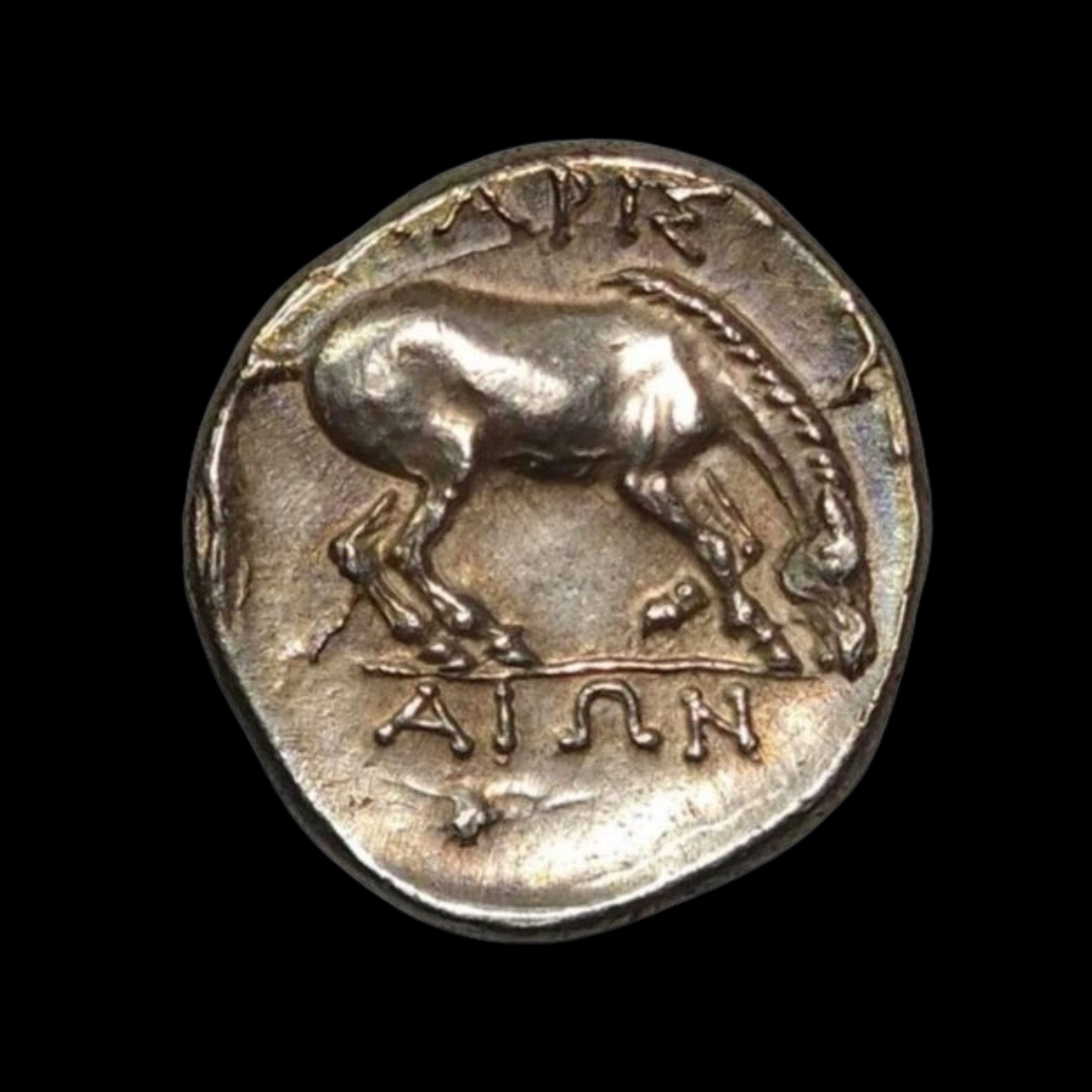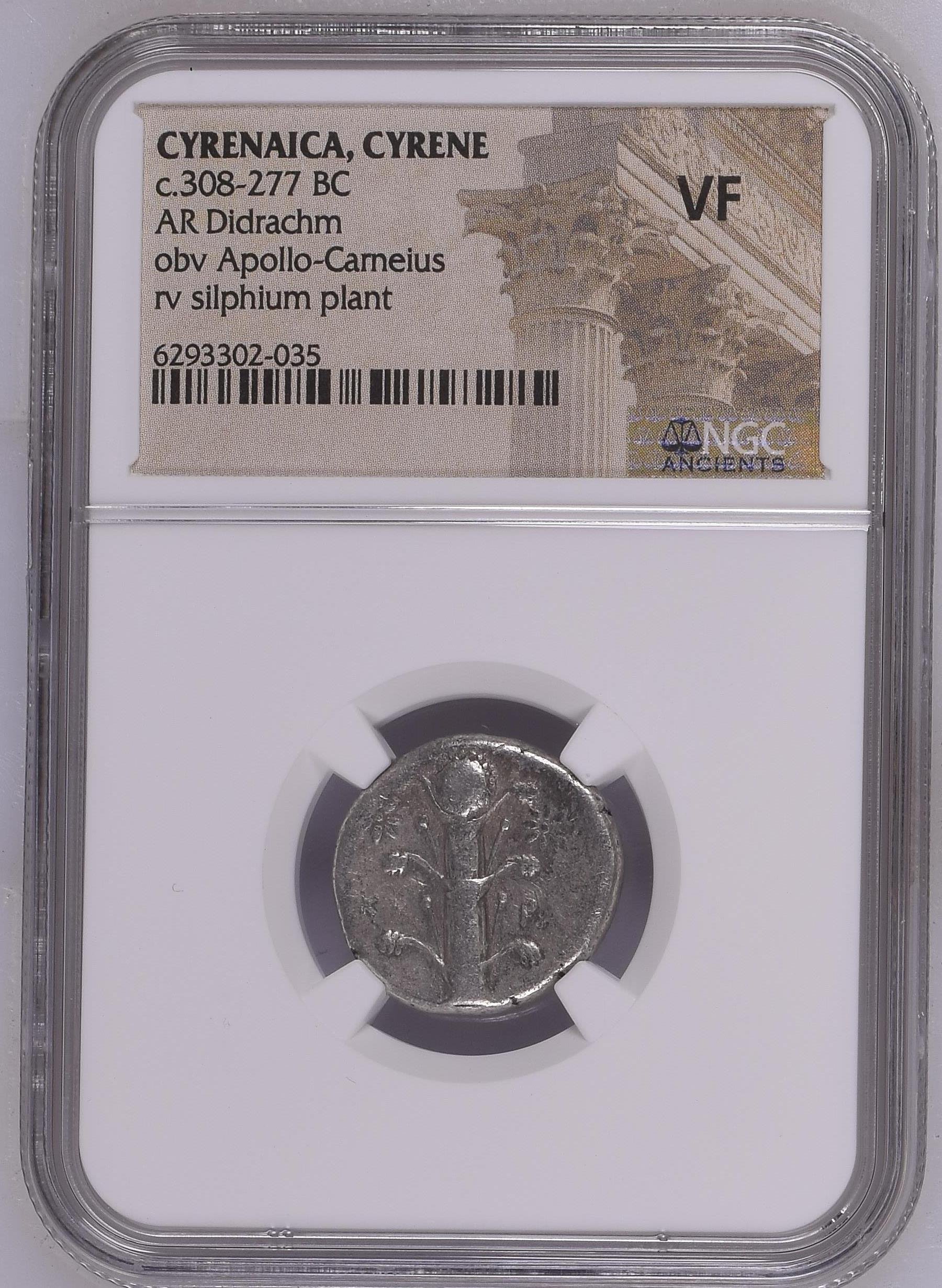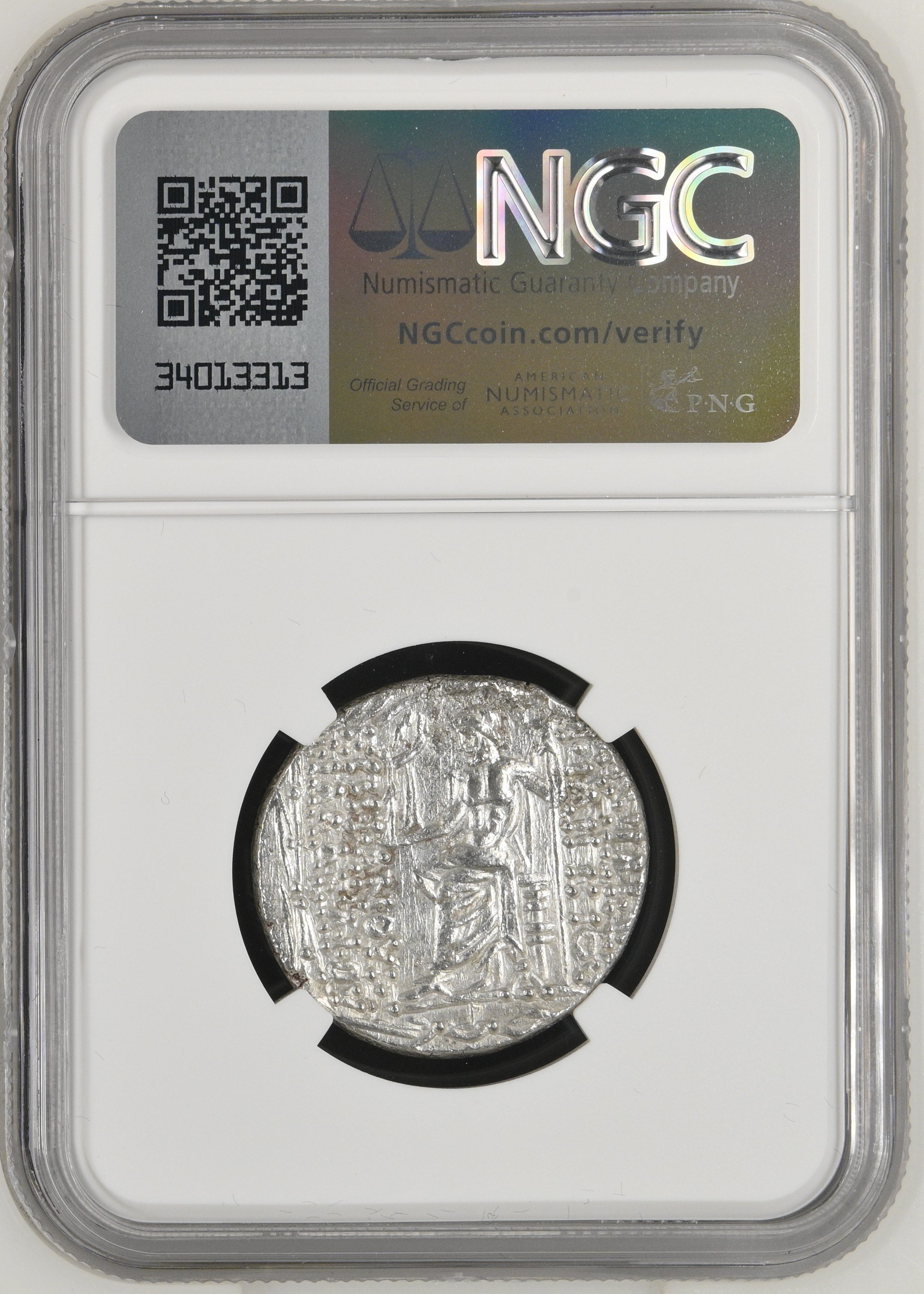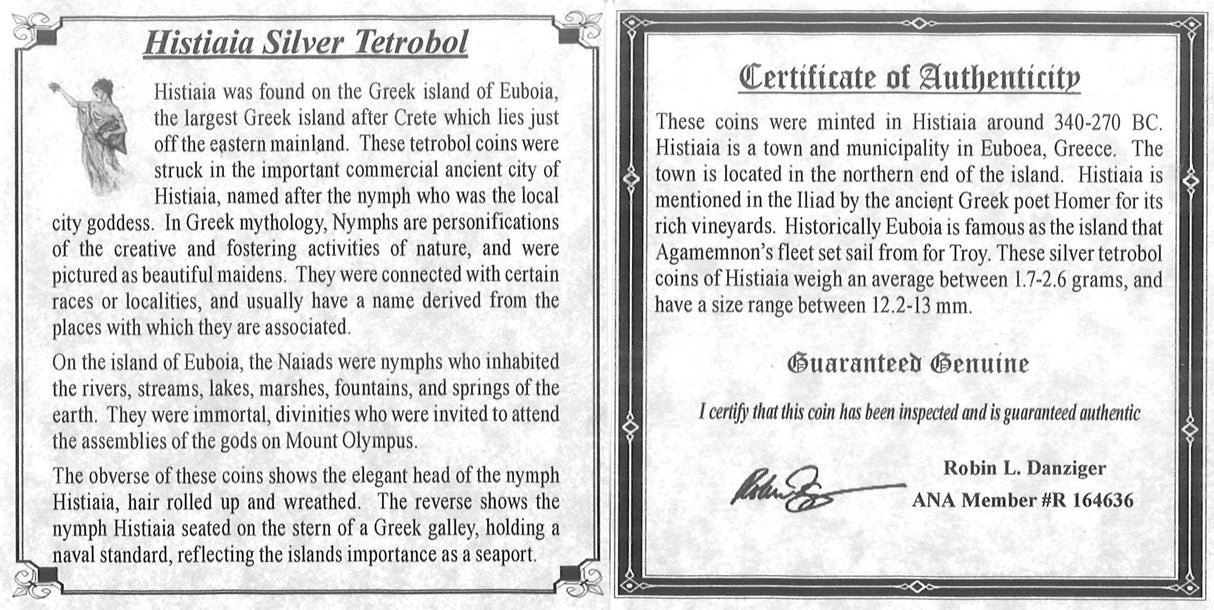 Image 1 of 2
Image 1 of 2

 Image 2 of 2
Image 2 of 2



Ancient Bronze Coin from Northern Syria: Made when Mark Antony and Cleopatra ruled the region (about 2,050 years ago)
This small bronze coin was minted in northern Syria during the joint rule of Mark Antony and Cleopatra, shortly after they formed their political alliance. It represents a fascinating period when Roman and Egyptian influence merged in the Eastern Mediterranean region (modern-day Syria).
Coin Description:
Front side: Profile portrait of Mark Antony facing right, wearing a laurel wreath with his name and titles in Greek letters around the edge
Back side: Profile of Cleopatra facing right, wearing a diadem crown with Greek inscription identifying her as "Queen Cleopatra"
Technical Details:
Material composition: Bronze with dark green-brown patina
Denomination: AE18 (bronze coin approximately 18mm in diameter)
Catalog/reference numbers: RPC 4094, Sear 1563
Certification/grade: VF (Very Fine), slight wear on high points
Date/period of minting: 37-36 BCE during the Antioch mint operations
Historical Significance: This coin was issued shortly after Mark Antony formed his alliance with Cleopatra VII of Egypt, serving as propaganda to legitimize their joint authority in the eastern provinces (Syria). The coin circulated during the period leading up to their conflict with Octavian (later Emperor Augustus), which would culminate in their defeat at the Battle of Actium. In the monetary system of the time, these small bronze coins were used for everyday local transactions by common people in marketplaces throughout northern Syria.
This small bronze coin was minted in northern Syria during the joint rule of Mark Antony and Cleopatra, shortly after they formed their political alliance. It represents a fascinating period when Roman and Egyptian influence merged in the Eastern Mediterranean region (modern-day Syria).
Coin Description:
Front side: Profile portrait of Mark Antony facing right, wearing a laurel wreath with his name and titles in Greek letters around the edge
Back side: Profile of Cleopatra facing right, wearing a diadem crown with Greek inscription identifying her as "Queen Cleopatra"
Technical Details:
Material composition: Bronze with dark green-brown patina
Denomination: AE18 (bronze coin approximately 18mm in diameter)
Catalog/reference numbers: RPC 4094, Sear 1563
Certification/grade: VF (Very Fine), slight wear on high points
Date/period of minting: 37-36 BCE during the Antioch mint operations
Historical Significance: This coin was issued shortly after Mark Antony formed his alliance with Cleopatra VII of Egypt, serving as propaganda to legitimize their joint authority in the eastern provinces (Syria). The coin circulated during the period leading up to their conflict with Octavian (later Emperor Augustus), which would culminate in their defeat at the Battle of Actium. In the monetary system of the time, these small bronze coins were used for everyday local transactions by common people in marketplaces throughout northern Syria.
This small bronze coin was minted in northern Syria during the joint rule of Mark Antony and Cleopatra, shortly after they formed their political alliance. It represents a fascinating period when Roman and Egyptian influence merged in the Eastern Mediterranean region (modern-day Syria).
Coin Description:
Front side: Profile portrait of Mark Antony facing right, wearing a laurel wreath with his name and titles in Greek letters around the edge
Back side: Profile of Cleopatra facing right, wearing a diadem crown with Greek inscription identifying her as "Queen Cleopatra"
Technical Details:
Material composition: Bronze with dark green-brown patina
Denomination: AE18 (bronze coin approximately 18mm in diameter)
Catalog/reference numbers: RPC 4094, Sear 1563
Certification/grade: VF (Very Fine), slight wear on high points
Date/period of minting: 37-36 BCE during the Antioch mint operations
Historical Significance: This coin was issued shortly after Mark Antony formed his alliance with Cleopatra VII of Egypt, serving as propaganda to legitimize their joint authority in the eastern provinces (Syria). The coin circulated during the period leading up to their conflict with Octavian (later Emperor Augustus), which would culminate in their defeat at the Battle of Actium. In the monetary system of the time, these small bronze coins were used for everyday local transactions by common people in marketplaces throughout northern Syria.
Cleopatra VII Thea Philopator (Koinē Greek: Κλεοπάτρα Θεά Φιλοπάτωρ lit. 'Cleopatra father-loving goddess';[note 5] 70/69 BC – 10 August 30 BC) was Queen of the Ptolemaic Kingdom of Egypt from 51 to 30 BC, and its last active ruler.[note 6] A member of the Ptolemaic dynasty, she was a descendant of its founder Ptolemy I Soter, a Macedonian Greek general and companion of Alexander the Great.[note 7] Her first language was Koine Greek, and she is the only Ptolemaic ruler known to have learned the Egyptian language.[note 8] After her death, Egypt became a province of the Roman Empire, marking the end of the last Hellenistic-period state in the Mediterranean, a period which had lasted since the reign of Alexander (336–323 BC).[note 9]
In 58 BC, Cleopatra presumably accompanied her father, Ptolemy XII Auletes, during his exile to Rome after a revolt in Egypt (a Roman client state) allowed his daughter and rival, Berenice IV, to claim his throne. Berenice was killed in 55 BC when Ptolemy returned to Egypt with Roman military assistance. When he died in 51 BC, Cleopatra began reigning alongside her brother Ptolemy XIII, but a falling-out between them led to an open civil war. Roman statesman Pompey fled to Egypt after losing the 48 BC Battle of Pharsalus in Greece against his rival Julius Caesar (a Roman dictator and consul) in Caesar's civil war. Pompey had been a political ally of Ptolemy XII, but Ptolemy XIII, at the urging of his court eunuchs, had Pompey ambushed and killed before Caesar arrived and occupied Alexandria. Caesar then attempted to reconcile the rival Ptolemaic siblings, but Ptolemy's chief adviser, Potheinos, viewed Caesar's terms as favoring Cleopatra, so his forces besieged her and Caesar at the palace. Shortly after the siege was lifted by reinforcements, Ptolemy XIII died in the Battle of the Nile; Cleopatra's half-sister Arsinoe IV was eventually exiled to Ephesus for her role in carrying out the siege. Caesar declared Cleopatra and her brother Ptolemy XIV joint rulers but maintained a private affair with Cleopatra that produced a son, Caesarion. Cleopatra traveled to Rome as a client queen in 46 and 44 BC, where she stayed at Caesar's villa. After Caesar's assassination, followed shortly afterwards by that of Ptolemy XIV (on Cleopatra's orders), she named Caesarion co-ruler as Ptolemy XV.
You Might Also Like












